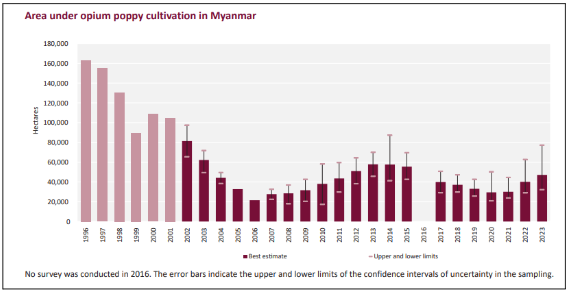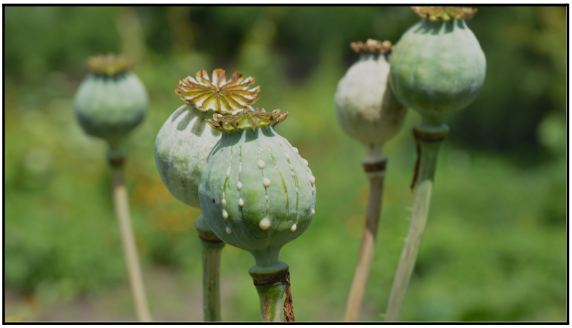GS Paper - 3
Why in the news?
The United Nations Office on Drugs and Crime (UNODC) has issued its Southeast Asia Opium Survey 2023,
- It provides an evaluation of opium poppy cultivation in the region.
- The Golden Triangle encompasses a clandestine opium production region that spans Myanmar, Thailand, and Laos.
- On the other hand, the Golden Crescent is characterized by illicit opium production zones situated in Iran, Afghanistan, and Pakistan.
Key Findings
- Myanmar is now the biggest supplier of opium worldwide, taking the lead after a drop in opium production in Afghanistan.
- A specific study showed that there's a notable amount of opium cultivation happening in the Sagaing area, along Myanmar's border with India.
Opium
Southeast Asia's historical entanglement with opium spans centuries, leaving an indelible mark on the region's socio-economic and political landscape. The cultivation of opium poppies, coupled with the subsequent processing into derivatives like morphine and heroin, has wielded substantial influence, shaping the intricate dynamics of the area.
Historical Context:
- Early Cultivation: Opium poppy cultivation in Southeast Asia is believed to have started in the 17th century, mainly in mountainous regions like the Golden Triangle, covering parts of Myanmar, Thailand, and Laos.
- Colonial Trade: During the era of European colonialism, notably by the British, there was active promotion of opium production and trade across Southeast Asia. This served both as a revenue source and a means of exerting control over local populations.
- Golden Triangle Formation: The 20th century witnessed the Golden Triangle evolving into a significant hub for opium production and trafficking. This transformation was driven by political instability and conflicts in the region.
Current Trends in Opium Cultivation
Cultivation Area: Opium poppy cultivation has surged by 18%, expanding from 40,100 hectares in 2022 to 47,100 hectares in 2023. This notable escalation marks the highest recorded level since 2014.
- Production: Opium production is believed to have risen by 13%, reaching a multi-year peak of 725 tons.
- Regional Distribution: Myanmar continues to be the primary producer, contributing to 91% of the region's cultivation area and 88% of the potential production.
- Increased Yields: The average opium yield per hectare has reached an all-time high of 22.9 kg, indicating advancements in farming methods and increased investment in irrigation and fertilizers.
Factors Influencing Opium Production
The determinants impacting opium production in Southeast Asia are intricate and varied, involving economic, political, social, and environmental dimensions.
Here's an overview of essential factors:
Economic:
- Economic hardship and absence of alternative livelihoods:
- Numerous farmers in areas where poppy cultivation is prevalent face challenges like limited access to education, land ownership, and stable income sources.
- Despite the illegal and risky nature of opium cultivation, it remains an attractive option for quick cash.
- Fluctuating opium prices:
- Global market variations in opium prices can drive an increase in production, especially when prices surge due to shortages or disruptions in other regions.
- Corruption:
- Inadequate governance and corruption can create an environment conducive to opium production.
- Weak enforcement and opportunities for officials to benefit from the trade contribute to the thriving opium economy.
Political
- Instability and conflict:
- Civil conflicts and insurgencies in nations like Myanmar have led to power vacuums and law enforcement disruptions, providing fertile ground for the growth of poppy cultivation in areas without effective governance.
- Demand for opium and its derivatives:
- The persistent global demand for heroin and other opium derivatives remains a driving force behind production in Southeast Asia, despite ongoing international endeavors to curb trafficking and consumption.
Social:
- Cultural traditions:
- In certain communities, the cultivation and use of opium poppies have become deeply embedded in traditional practices and rituals, posing a challenge to eradication efforts without addressing the underlying cultural norms.
- Limited awareness and education:
- Farmers may lack comprehensive awareness regarding the adverse effects of opium production, including environmental harm, health risks, and social stigma.
Drug Trafficking a Challenge to India's Security
- Cross-Border Smuggling: Illicit narcotics frequently move across borders, with neighboring countries such as Afghanistan, Pakistan, and Myanmar serving as sources.
- Organized Crime and Violence: Drug trafficking is often linked to organized criminal networks involved in violent activities.
- Threat to National Security: Routes utilized by drug traffickers may double as conduits for smuggling weapons and potentially facilitating the movement of terrorists.
- Corruption and Money Laundering: Drug proceeds might be laundered through formal financial channels, posing a threat to economic integrity.
- Healthcare Burden: Substance abuse places a significant burden on the healthcare system.
Way Forward
To tackle the opium cultivation and trafficking highlighted in the Southeast Asia Opium Survey 2023, India and neighboring countries can leverage existing norms and data:
- Leverage Existing Cooperation Mechanisms: Strengthen platforms for intelligence sharing and collaboration among affected countries, using established frameworks like the UNODC and regional law enforcement agencies.
- Promote Alternative Livelihoods: Implement sustainable development projects to provide alternative incomes for opium-dependent communities, drawing from successful models like crop substitution programs and vocational training.
- Enhance Border Security Measures: Utilize advanced technology and expertise from existing border security initiatives to improve detection and interception of illicit drug trafficking.
- Community Engagement: Mobilize communities through awareness campaigns, utilizing strategies proven effective in past anti-drug campaigns to educate about the harms of opium cultivation and encourage participation in eradication efforts.
- Legal Enforcement: Enforce existing laws and penalties for drug-related offenses, utilizing established legal frameworks and judicial mechanisms to prosecute offenders and confiscate illicit assets.
- International Collaboration: Seek support from international organizations and donor agencies to fund anti-drug initiatives, leveraging existing partnerships and cooperation mechanisms for shared resources and expertise.
- Environmental Conservation: Integrate environmental considerations into development projects, drawing from successful conservation efforts to mitigate the ecological impact of opium cultivation.
- Healthcare Services: Strengthen healthcare systems to provide addiction treatment and rehabilitation services, leveraging existing infrastructure and expertise in addiction treatment and mental health services.
By leveraging existing norms and data-driven solutions, India and neighboring countries can effectively address the challenges posed by opium cultivation and trafficking, fostering a safer and more prosperous region.


